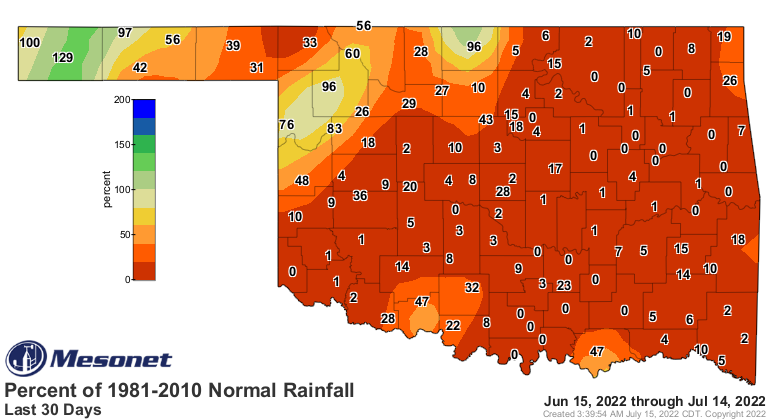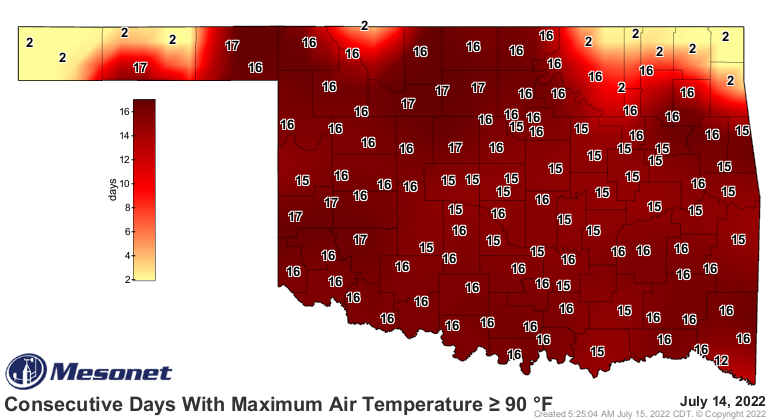Cow-Calf Corner | July 18, 2022
Mid-Year Cattle Cycle Update
Derrell S. Peel, Oklahoma State University Extension Livestock Marketing Specialist
On July 22, USDA-NASS will release the July Cattle report with national estimates of cattle inventories by category along with the first estimate of the 2022 calf crop. With widespread drought conditions continuing in 2022, the focus will certainly be on the female side of the industry in terms of how much beef cow herd liquidation has occurred and how much more is ahead. What we know now is how much female slaughter has already occurred. Beef cow slaughter was up 14.6 percent year over year in the first half of the year. This follows a nine percent increase in beef cow slaughter last year. The beef cow herd inventory is likely to be down by 2.5-3.0 percent in the mid-year inventory. This would be a July 1 beef cow inventory that is the smallest since 2015 or earlier.
Fed cattle slaughter was up 0.6 percent year over year in the first half of the year. However, fed steer slaughter was down 1.4 percent while fed heifer slaughter was up 3.8 percent year over year. Heifer slaughter in the first half of the year was 52.1 percent of the January 1 inventory of other heifers. That is the highest rate of heifer slaughter in the first half of the year since 2004 and has averaged 48.3 percent in the past fifteen years. Reduced beef heifer retention may lead to a decrease in the beef replacement heifer inventory of 2.5 percent or more.
The 2022 calf crop is expected to be smaller by roughly two percent. Lower inventories of steers, other heifers and calves, combined with a cattle on feed inventory about equal to last year, is expected to lead to a roughly three percent decrease year over year in estimated feeder supplies outside of feedlots. The total July 1 inventory of all cattle and calves is expected to be down by 2.0-2.5 percent year over year.
The beef cattle industry is liquidating farther and faster this year. Augmented by continuing drought and high input prices, accelerated cow and heifer slaughter so far is boosting beef production in the short term but leading to a smaller than planned industry going forward. At some point, drought conditions will likely ease and producers will be interested in herd rebuilding. The timing will be important, and it may take some time. Cow culling can drop rather quickly if conditions improve but the availability of replacement heifers, especially bred heifers, may take a year or more. Heifer liquidation this year may mean that a limited supply of bred heifers is available next year. If drought conditions improve this summer/fall, it may be possible to save some additional replacement heifer calves, but most will not calve until 2024. Even if we can and want to, the ability to rebuild the beef cow herd may be limited in 2023. Hopefully, the upcoming report will provide some indication of what lies ahead.
Benefits of Early Weaning Beef Calves
Mark Z. Johnson, Oklahoma State University Extension Beef Cattle Breeding Specialist
Long-term drought, May moisture, extreme heat and prevailing southern winds for the past several weeks have resulted in a flash drought. Many Oklahoma cow-calf operations are facing the reality of a depleted forage base right now. One potential solution is early weaning calves. Early weaning calves has the primary benefit of improving cow condition for rebreeding, especially when forage is limited. When the nutritional demands of lactation are removed by early weaning there is significant reduction (15 – 20%) in the dietary energy needed by cows. Early weaning can initiate postpartum estrus, improve pregnancy rates, lower culling rates and result in higher weaning weights and cow productivity in following years. Early weaning is most beneficial in years when pasture production is inadequate to support herd nutritional requirements. From the standpoint of range management, it reduces the risk of overgrazing and accordingly adds to the long-term health of the grazing system.
The average age of beef calves weaned in the United States is a little over 7 months of age. Calves can be weaned as early as 60 days of age. However this requires intensive calf management and is not practical under most ranch conditions. At two months of age calves are still functionally pre-ruminants relying primarily on milk and consuming a small amount of forage. By 3 – 4 months of age the rumen becomes functional and calves are capable of consuming significant amounts of forage.
Best Management Practices for Early Weaning
The first two weeks post weaning are a critical time for calves to overcome weaning stress, maintain health and become nutritionally independent by learning to consume feed. Manage according the following:
- Lower the risk of health problems and promote calf growth by giving proper vaccinations prior to weaning. Castrate and dehorn calves when giving pre-weaning vaccinations. This will permit calves to deal with the stress of these management practices while still nursing.
- Manage to get calves accustomed to a feed bunk and water trough as quickly as possible. Creep feeding calves for a few weeks prior to weaning will ease the transition and get calves accustomed to concentrate feed. Maintain access to good quality, clean water at all times.
- Fence line wean if possible. This eliminates stress by permitting calves to remain in the same pasture where they are familiar with feed, water, shade, etc.
- The feed ration is critical because feed intake is initially low after weaning. It needs to be highly palatable, nutrient dense, dust free and include a complete vitamin and mineral supplement.
- After calves are over the stress of weaning they should begin to consume approximately 3% of their body weight in high quality feed each day. Feed intake variation or depressed appetite can indicate health problems.
Plan Now to Make It Through the Winter: Part I
Paul Beck, Oklahoma State University Extension Beef Nutrition Specialist
It has been hot and dry this summer. The maps from Mesonet below show that in the last 30 days much of Oklahoma has had less than 10% of our normal rainfall and over 2 consecutive weeks of maximum temperatures in excess of 90°. Worries about drought and how we are going to make it through the winter with limited or no stored forage has monopolized most of our thoughts, energy, and time. There are some critical steps that need to be made in order for us to make it.
Our first priority is to reduce the stocking rate on the ranch to a level that can be sustained through the rest of the summer and into the fall.
- If you are one of the operations that keeps or purchases stocker calves to utilize extra grass, this may be the time to sell calves early or send calves to a grow yard or feedlot. Using stocker calves as part of the “normal” stocking rate of the ranch allows for producers to be flexible for drought and other adverse weather events. Many operations use 30 to 50% of their summer forage for stockers in normal years, when forage production is limited these calves can be marketed reducing the culling of the cowherd that may need to occur.
- Selling replacement heifers should also be considered, these females will not provide a marketable calf for over a year. In this current circumstance, these cattle may be too large of a drain of resources.
- Cull cowherd to a number that you can afford to winter by getting rid of old cow, less productive cows and/or cows that have higher nutrient requirements. Cows that are expected to calve in the fall will require more nutrients to keep them in proper condition, and a higher level of nutrition equates to higher cost of winter feeding. The number of cows remaining may be the actual sustainable long-term carrying capacity for your operation.
- Cross-fence your farm now before you have to start feeding hay. You will be surprised how much forage growth you will have if you allow pastures to rest. Once you have the farm subdivided you can utilize these pastures in a rotational grazing system in the future and may have the additional benefit of increased pasture health and improved harvest efficiency. Keep cows on a smaller area of your farm while you are feeding hay, this sacrifice paddock will allow much of the ranch a rest and concentrate the nutrients from hay feeding.
These steps may not be palatable, because we may have to change the way we do things, it may take more work than what we want to put in, or it may cost more than we want to spend. Our overarching goal should be to have an intact cattle operation when we get through this dry spell.


